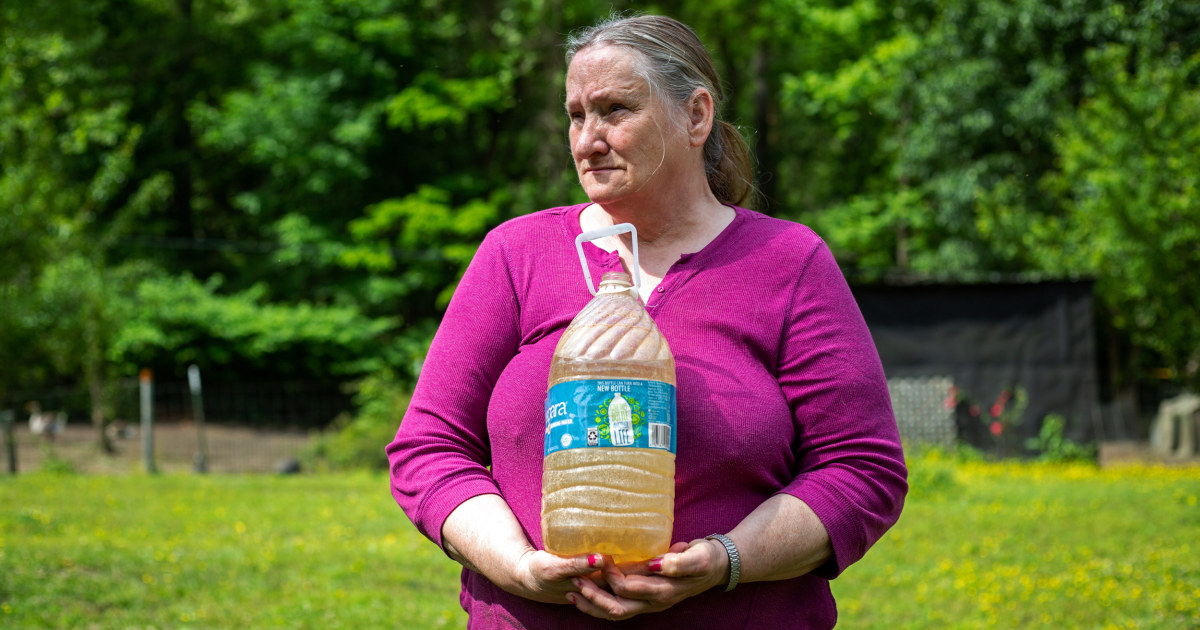
BRADSHAW, W.Va. — Every week, Burlyn Cooper parks on the edge of a winding two-lane road, unloads a dozen plastic jugs from the trunk of his car, and uses a hose to fill them with the spring water that drips from a mountain’s exposed rock face. For Cooper and many of his neighbors, the mountain’s runoff is their most reliable, and trusted, source of drinking water.
“I’ve got so used to it, I wouldn’t know how to act, to turn the faucet on and have good water,” he said. “I can’t imagine it.”
Cooper and his wife, Hazel, once depended on wells for water. More than 43 million Americans use wells, which can be a plentiful source of clean water. Today, however, the Coopers’ two wells are too polluted to drink from — the result, they suspect, of nearby natural gas extraction. The once-clear water, which they now only use to wash themselves and water their animals, is orange and sour-smelling. It leaves a thick sludge in their sinks, rust-colored stains on their taps and clothes, and an itchy, red rash on Burlyn’s skin.
So the Coopers gather water however they can, as do many other residents of McDowell County, once the crown jewel of coal country and now among the nation’s poorest counties. They haul roadside water, collect rainwater in tanks, or spend their limited income on bottled water, all because they lack safe and reliable water and plumbing at home.
“It don’t matter if you’re around here or there,” Cooper said. “In McDowell County, seems like all the water’s bad.”
For more on this story, watch Stephanie Gosk tonight on “NBC Nightly News with Lester Holt”
An estimated 2 million Americans live without access to either safe drinking water, indoor plumbing or basic sanitation, according to DigDeep, a nonprofit that works to bring water to Americans without it. This “water access gap” disproportionately affects low-income, rural communities and people of color — communities left behind by the massive national investment in public water infrastructure in the past century.
“This is absolutely at an individual, community, and nation level a crisis,” said George McGraw, founder and CEO of DigDeep.
Ending that crisis, especially in McDowell County, is a complex task.
Welcome to McDowell
McDowell County is rich with water. Rivers and streams course through dense forests. But a confluence of economic decline, aging infrastructure and rugged terrain has made it an uphill fight to bring that water to people’s taps.
Seventy years ago, more than 100,000 people called McDowell home. Coal was king. In the 1950s, its mountains produced more coal than any other U.S. county. The middle class grew and its towns boasted department stores, restaurants and movie theaters.
But as the coal industry mechanized in the ’60s, mines began shutting down. McDowell was hit again 20 years later, when the decline of the American steel industry took many of the remaining jobs.
The county’s population now hovers somewhere around 17,600 people. Thirty-three percent of its population lives below the poverty line. The dearth of economic opportunity has forced an exodus of young and working-age people, leaving behind a graying population and a minimal tax base to fund development and infrastructure.
Today, many McDowell residents are living through a water crisis, McDowell County Commissioner Cody Estep said. Some towns have been under boil-water advisories for years. Many locals rely on wells, but those are vulnerable to contamination from their surroundings, and can be expensive to fix. An estimated two-thirds of homes lack basic wastewater treatment, and many homeowners pipe waste straight into nearby streams. “People are beat down,” he said. “Our population is aging. They’re not able to haul water like they used to. Wells are dried up.”
In the past 18 years, McDowell County’s Public Service District, the county’s public water utility, has taken over nine local water systems, and is set to take control of more soon — most of them small systems built and once maintained by coal companies.
“We’re dealing with leaks, we’re dealing with overages, we’re dealing with customer complaints, and we know it’s going to be several years before we can get the funding to replace those systems,” Mavis Brewster, the PSD’s general manager, said.
The utility has at least a dozen improvement projects on its wish list, she said. But it doesn’t have the money. Water systems are among the most expensive types of infrastructure to build and maintain, and public water utilities are largely funded by the rates customers pay them. A dwindling, low-income population means fewer rate payers, and less money for necessary upgrades.
Cash-strapped rural utilities often finance upgrades through a patchwork of state and federal funds, including loans from the U.S. Department of Agriculture. But McDowell is already saddled with debt from such loans, Brewster said, and pays about $34,000 to cover it each month. That means she and her team spend a substantial amount of time applying for grants, so the utility won’t have to take on more debt or raise rates.
In the meantime, Brewster fields a steady stream of calls from residents crying out for public water.
“In this day and time, everyone should have clean, dependable public water if they choose,” she said. “That’s just a very basic need. It’s hard for me to imagine that people in the United States don’t have that, and can’t get it, [or that] you can’t get the funding approved for the project to provide that to those people.”
‘Be patient’
In 2012, the McDowell PSD extended public water lines up part of Bradshaw Mountain, to the taps of some 450 households and businesses. But the funding only went so far. Delphine Stacy and her husband, Burl, live just 1 mile past the end of the water line, and the PSD has been unable to secure grants to extend it further. The Stacys’ well dried up years ago.
Stacy calls Brewster nearly every week to ask for news about the water lines. She calls Estep, the county commissioner. She’s even called West Virginia‘s governor, Jim Justice, who owns several coal mines in McDowell.
The connection to public water would cut her monthly water costs from about $100 to about $30. Disabled and on a fixed income, the extra $70 could go a long way for her.
“They tell me to be patient,” Stacy said.
Estep, who was born and raised on Bradshaw Mountain, does what he can to help residents like the Stacys, hauling plastic water tanks up the mountain and finding equipment they need for repairs. While state and local officials like himself failed to plan for the future, he said, he also feels like the county has been left behind.
McDowell needs industry and jobs to grow, but it can’t attract economic opportunity without basic infrastructure, like water. To solve its water crisis, he said, the county that once helped power the nation needs federal help.
“We’re not begging, pleading for money as much as we are asking for a helping hand,” he said. “Just help us get back on track here. … Give us something to start with, and we’ll take it from there.”
The U.S. has increasingly extended that kind of helping hand in its international water aid efforts. Congress passed two laws prioritizing water security in international aid and the amount of U.S. Agency for International Development money devoted to global water security projects grew 50 percent between 2008 to 2020, from $300 million to 450 million annually. But federal investment in domestic water infrastructure, while far larger at more than $18 billion annually, plateaued decades ago.
During the 20th century, the percentage of Americans without water and sanitation access declined rapidly. From the New Deal through the 1970s, federal initiatives funded the creation of small water systems across the country. But the burden of funding water infrastructure shifted increasingly to states and local governments beginning in the ’80s, as federal funding efforts stagnated and shifted more toward loan than grant funding.
Meanwhile, Americans of color and rural communities have fallen through the cracks, said McGraw, DigDeep’s founder. There is little federal data on the demographics of water and sanitation access, but recent research conducted by the nonprofit found that race is the strongest predictor of access, with Black and Latino families twice as likely as white families to lack running water. More than 17 percent of rural Americans report having experienced issues accessing safe drinking water. The challenges span the country, from McDowell to the Navajo Nation, from Texas border towns to the Alabama-Mississippi Black Belt.
“In some places in the country that gap is widening,” McGraw said. “And if we don’t start massively investing in this infrastructure that’s literally falling apart underneath us, it’s going to get a lot bigger.”
‘Heartbreaking’
Elizabeth Mason, 79, has planted peonies and other flowers around the house where she and eight siblings were raised in Kyle Bottom, a small neighborhood just off Route 52. Her father was a coal miner. The house had water when she was growing up, piped in through lines laid long ago by a coal company. But the pipes became unreliable a decade ago and residents have dealt with water outages and contamination for years.
Sometimes the water is out for weeks, and Mason has to rely on family and neighbors to haul water from a roadside spring and store it in barrels on her porch.
“Can you imagine not being able to take a shower?” she said. “Can’t wash dishes. Trying to cook with contaminated water. It’s hard to imagine, unless you experience it.”
She needed that help when, last January, after her 76-year-old sister entered the hospital with Covid-19, the water went out again. Her sister died and the water didn’t come back. Without water, Mason couldn’t cook for her family or bathe in her bathroom, and she couldn’t have relatives stay at her home while they visited to attend her sister’s funeral.
“It was heartbreaking,” she said.
Her water system is one of those the county’s public water utility will take over. The PSD has been replacing water lines that snake through a series of small towns, and also making other upgrades — a multimillion-dollar, grant-funded project that will connect nearly 1,000 households and businesses to new water lines when completed.
But homeowners like Mason will have to pay their share to connect new service lines to public water — a cost that, at about $1,200, is out of reach for many people in McDowell.
Mason got a hand from DigDeep, which recently launched the Appalachia Water Project, a series of initiatives to decrease the water access gap in the region. So far, the nonprofit has helped more than 50 McDowell households connect to the PSD’s new water lines, and hundreds more may follow suit.
Mason’s water was scheduled to be switched on in early June. That was until the equipment needed to finish the job broke.
“I waited this long,” she said, seated on her front porch where, just a few feet away, her emergency reserve of water sits in a barrel and a dozen gallon jugs. “A few more weeks won’t make much difference.”
Next generation
An hour’s drive away, Hazel and Burlyn Cooper have lived for decades butted up against a railroad track near Bradshaw Mountain, with a menagerie of animals, including DH the turtle, Big Mommy the horse, and Squeakers the baby goose.
Like other families who live farther up the mountain, their wells have become so laden with contaminants the water is no longer safe to drink. It was after a company drilled for natural gas near their home, the Coopers said, that the water went bad. Now, securing water is a daily chore.
“If you ain’t got water, you got nothing,” Hazel said. “You ain’t going to survive.”
Scores of homes across Appalachia, an area rich in natural gas deposits, have experienced similar issues with well water, said Leigh-Anne Krometis, associate professor at Virginia Tech’s Department of Biological Systems Engineering. But the connection between contamination and industrial activity, such as mining and fracking, is often impossible to prove. (A spokesperson from West Virginia’s Department of Environmental Protection said it routinely inspects sites that have been issued permits by the agency to ensure compliance with state and federal regulations.)
Krometis and a graduate student tested the Coopers’ wells, along with nine other home wells in the county. In the Coopers’ wells, they found levels of iron, manganese, strontium and barium far exceeding EPA drinking water standards and recommendations. They also tested the roadside spring where the Coopers gather water, finding E. coli and other coliform bacteria, which could come from animal or human waste.
A trade group representing energy companies that have drilled gas wells in McDowell did not immediately respond to a request for comment.
The county needs creative solutions, Krometis said. Home filtration systems are one option that could work for the Coopers. But even if McDowell gets an injection of federal funding for its water projects, she added, people like the Coopers might still get left behind.
“It’s going to take a long time to upgrade those water treatment plants, to get pipes running up and down those mountains,” she said. “In the meantime, people are still exposed.”
Neither Hazel nor Burlyn believe public water will flow through their taps in their lifetime. But they can’t imagine ever leaving, and not just because they don’t have the money. Because it’s home.
“I don’t think I’ll ever get water,” Hazel said. “I want to pass this house on to my grandkids. Maybe they’ll get to have water. That’s what I care about.”
Source: | This article originally belongs to Nbcnews.com










